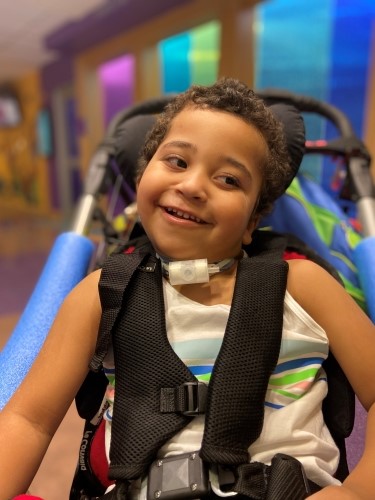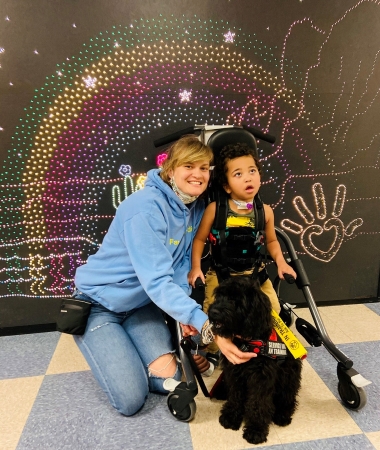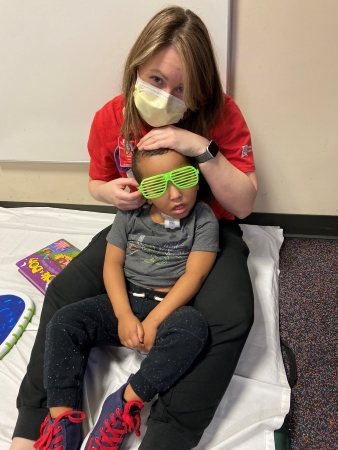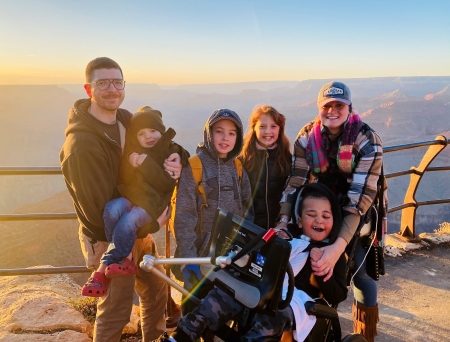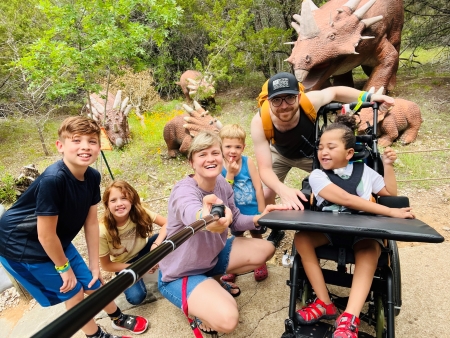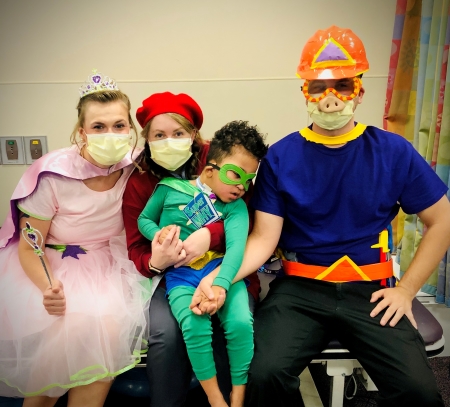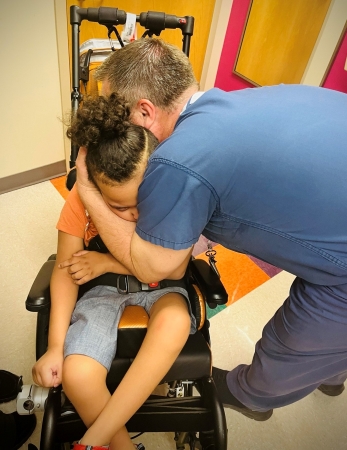Bright Futures
Articles and Updates from Phoenix Children's
Five-year-old LJ Akey is named for his grandfather Leonard – a name that means strong, brave and lion-hearted. Young Leonard James is all of those things, and much more.
Just as he was celebrating his first birthday in good health, LJ’s small body started to fail him rapidly. He began to lose his balance, and when he fell, his mother noticed that he struggled to get back up. Within two weeks, he was no longer able to hold up his head, crawl or keep his pacifier in his mouth. Suddenly, LJ and his family found themselves on a medically complex and highly emotional journey that would take them to hospitals across multiple states, through countless tests and treatments, and ultimately into the care of a dedicated, innovative and compassionate team at Phoenix Children’s.
The Early Days and a Diagnosis
LJ was a typical baby. At home in Las Vegas with his parents, Austin and Amanda, and his three siblings, LJ met all expected milestones, learning to crawl, taking his first steps and listening to his favorite Dr. Seuss stories. Amanda noticed LJ’s balance trouble just after his one-year checkup. Although his pediatrician could find nothing wrong, she was concerned and referred LJ to the local emergency department.
During the next two weeks, LJ underwent test after test that yielded no definitive diagnosis.
“The doctors didn’t know what was causing it, and we were in a race against time,” recalled Amanda. “LJ was declining so very fast that the doctors basically told us to enjoy the time we had with him. We were terrified.”
In desperation, Austin wrote a letter to Mayo Clinic, and they agreed to see LJ the following week. There, LJ was diagnosed with an exceedingly rare, life-threating condition called “hypermanganesemia with dystonia.” At the time, only 11 other people in the world were known to have this degenerative disease.
“The body has a blueprint for how we develop and function,” explained Michael Kruer, MD, director of the Pediatric Movement Disorders Program, part of the Barrow Neurological Institute at Phoenix Children’s, who would ultimately become LJ’s physician when the Akeys could not find help closer to home. “We are born with about 20,000 genes. In LJ’s case, a single one of those thousands of genes has a typo – the one that regulates the level of manganese in his body. While we all need a certain amount of this mineral, toxic levels can damage the brain and bones. This is what was happening to LJ. His body couldn’t get rid of the excess manganese, and the deposits in his brain were causing two opposing issues: muscle weakness and involuntary, often painful muscle contractions, called dystonia.”
In Search of a Treatment: The “Yes” from Dr. Kruer
While there was – and still is – no official treatment for excess manganese, Mayo Clinic recommended the Akeys try chelation, a procedure that uses medication to attract and remove certain metals from the body. To be effective, the procedure would have to be performed frequently, so the Akeys returned home to Las Vegas to search for a hospital that could provide this care. The process was very discouraging; LJ’s medical condition was so grave and the treatment so unusual that most hospitals declined to attempt care.
Enter Dr. Kruer and Phoenix Children’s. Dr. Kruer’s research lab studies rare genetic disorders in children that are related to toxic metal accumulations. Although LJ’s diagnosis was somewhat different, Dr. Kruer learned of LJ’s case through a Mayo Clinic contact, and he reached out to Amanda.
“Dr. Kruer said ‘yes’ when everyone else said ‘no,” said Amanda, emotionally. “I call him our hope-bringer!”
Amanda and LJ flew to Phoenix immediately.
“LJ was an adorable toddler,” recalled Dr. Kruer. “He had lost his ability to speak, and he had experienced a significant decline in his motor skills. But his smile lit up the room, and his family was amazing. There is very little in the clinical literature about hypermanganesemia, but when we started LJ on chelation, his manganese levels dropped by 70%. That was the good news. The bad news was that they went back up just a few days after his treatments. It was disheartening. We were grasping at straws, trying to figure out how to treat LJ.”
The Wizardry of Dietitian Lisa Vanatta, Ningning Zhao, PhD, and Phoenix Children’s Pharmacy
This grasping led to a serendipitous finding – a research scientist knowledgeable about high levels of metals in the body who worked “just down the road.” Ningning Zhao, PhD, an associate professor in the School of Nutritional Science and Wellness at the University of Arizona in Tucson, studies how the body transports metals. Dr. Zhao’s research group has uncovered a crucial function of the gene that is mutated in LJ’s case. When working properly, this gene controls the amount of manganese absorbed by the body. When it is not working, the body absorbs drastically more manganese from the diet. During his research, Dr. Zhao also observed that a low-manganese diet prevented mice from getting sick despite having this genetic mutation.
Amanda had already reduced the amount of manganese in LJ’s diet to the best of her ability, but because it is an essential element and is in every food that comes from the ground, total elimination is very difficult. Manganese is also not listed on food labels, so assessing how much is in foods and supplements is nearly impossible.
For help in developing a low-manganese diet, Dr. Kruer turned to Lisa Vanatta, MS, RDN, CSP, the innovative and tenacious dietitian who developed and now leads the Ketogenic Program at Phoenix Children’s, which treats children with epilepsy using a ketogenic diet.
“I had taken a class in trace minerals in school, and honestly, I really couldn’t imagine at the time that I would ever use that information,” Vanatta recalled. “When Dr. Kruer asked for help, I had no idea how complex LJ’s condition was, but I began to research everything I could on manganese.
Vanatta’s first recommendation was to put LJ on a tube feeding so the team could calculate and control the amount of manganese that went into his body. She essentially created a formula for him from scratch, eliminating manganese by using modulars for fat, protein and carbohydrate sources, and then supplementing them with the vitamins and minerals needed to thrive. Chelation treatments also depleted his body of other metals, such as iron, so Lisa also took that into consideration as she developed LJ’s nutrition plan. The goal was to see if the diet, in combination with chelation, would prevent further buildup of manganese deposits and possibly even decrease manganese levels overall.
To support the team, Dr. Zhao offered to assess the manganese levels in every ingredient using his specially equipped lab, allowing the team to calculate exactly how much manganese LJ was receiving from his formula and supplements.
“We sent him all of it – even the water we used to mix the formula,” Vanetta said. “I created a spreadsheet of our ingredients and his analyses. We even asked him to analyze the brand of lollipop that LJ liked, partly to make sure LJ had something he enjoyed and partly to help him maintain his swallowing skills.”
At last, the team’s creativity and dedication paid off. Normal levels of manganese in the body are 1.2 mcg/L. When LJ started on the combined chelation and manganese-free diet, his manganese levels were over 100. Today, LJ is down to 4.2 – still too high, according to Dr. Kruer, but significantly safer than when he first arrived at Phoenix Children’s.
Beyond Clinical Stability: LJ’s Quality of Life
While stabilizing LJ was the most urgent challenge because of his life-threatening condition, his care team also worked diligently on two other vitally important aspects of treatment – making him comfortable and helping him learn to communicate.
“When we first met LJ, he spent 99% of his day almost unimaginably uncomfortable,” said Alex King, occupational therapist. “His muscle contractions were putting him into nearly impossible positions, and because he didn’t have a tracheostomy at the time to help him breathe, these positions made breathing and swallowing difficult.
“If you can imagine,” continued King, “here is this toddler whose body is fighting against him all day, every day. With movement disorders, each muscle contraction, each gasp for breath creates a cycle of anxiety that makes these contractions and breathing problems even worse. During our first weeks with him, we just worked to calm everything down in his room, teach his family how to remain calm as well, and help LJ find positions that would give him at least moments of comfort.”
The next step was to help LJ learn how to literally “turn off his body,” explained King, so that he could come out of a high state of arousal that increased his dystonia, or muscle contractions. “We call this ‘state regulation,’ and it requires a high level of mindfulness, a challenge for someone as young as LJ, but he is so motivated. LJ can now recognize when he needs to shut his body down – actually becoming like a rag doll – which is the first step in regaining control of his body’s reactions to stimulation.”
While temporarily helpful, this rag doll stage was not the final goal. Ultimately, LJ learned to re-engage with his surroundings without triggering severe dystonia. “He has become much more adept at this, so that now he can laugh, watch his shows, move his eyes and his head, and communicate with his family and with us – without triggering huge muscle contractions,” explained King. “That’s important for his quality of life. I’ve learned so much from LJ. He is incredibly present and resilient.”
Helping LJ learn to communicate was the goal for Jena Aebi, a speech-language pathologist at Phoenix Children’s. Aebi taught LJ to use an eye-gaze-driven assistive technology made by Tobii Dynavox. This device allows LJ to “talk” by moving his eyes to look at an image or a word on a screen.
“At first, this was really challenging because LJ was so young, and everything – even moving his eyes – triggered dystonia,” said Aebi. “He had to practice staying engaged with me and moving his eyes without causing other parts of his body to overreact.”
She started by helping him learn to request those things that calmed him, such as listening to music or watching his favorite programs. Now, at the age of 5, LJ has progressed significantly from those earlier days and can share his feelings as well as his needs. This year for Valentine’s Day, Aebi helped him “write” messages to people on his care team.
“I’ve saved them in my phone because they are so special to me,” said Aebi. “He wrote, ‘Alex, you are super, and Jena, you are fun,’” recalled Aebi with a smile.
Looking to the Future: A Big Move with the Phoenix Children’s Team in Full Support
When LJ first came under the care of the Barrow Neurological Institute at Phoenix Children’s, the Akey family moved from Las Vegas to Phoenix to be together. They try to do everything as a family, from learning about LJ’s medical care and his special needs to taking big trips together, visiting both the Grand Canyon and then Disney World. Amanda admits the trips were a juggle, but “the family pictures are worth it all!” she said smiling.
The Disney World trip also gave them time with both Amanda’s and Austin’s families who live in Orlando. Amanda recalled how much LJ and his siblings loved being with their grandparents and cousins, and the grandparents loved their special time with the children just as much.
Left to Right: Anthonie & Cienna (twins), Amanda, Eli, Austin and LJ
“We began to think about moving, but it seemed like such an enormous, emotional change,” said Amanda. “Phoenix Children’s has been our family from day one, but when I asked Dr. Kruer about it, he reassured me that LJ would be alright. He said, ‘I’m not going anywhere, and neither is the team. We’ll be available to you whenever you need us.’ I really needed to hear that. He made arrangements for LJ to receive care in Orlando.
Left to Right: Amanda Akey as Princess Pea; Jena Aebi, speech-language pathologist as Little Red Riding Hood; LJ as Whyatt Beanstalk; and Alex King, occupational therapist as the Littlest Pig.
“Leaving Phoenix Children’s has been hard,” said Amanda. “Everyone here loves the kids they care for. They embraced and loved LJ from the start. He was so small that he fit in their laps when he first arrived, and they took time to hold him this way. They have watched him grow, improve and learn. They’ve thrown birthday parties for him, made him special Vegas Knights blankets, and created heart-shaped support pillows and Teddy bears. They’ve been the recipients of his funny sense of humor and the side-eye he gives them when he makes a joke with his Dynavox.”
Amanda recalled one particular moment a few years ago when LJ was having a frightening episode, and she called Dr. Kruer. “I sent Dr. Kruer a video of what was happening,” Amanda recalled. “I didn’t realize it, but he was in an airport at the time, and he called us back right away. He directed LJ’s care from customs. Dr. Kruer was always there, always a support. I can’t put into words what that has meant for us.”
Sharing the Story to Help Others
For Dr. Kruer and the team who gave their expertise and their hearts to LJ and the Akey family, the next step is to write about their experience and findings. “We know LJ’s condition is rare, but there may be other children and families out there who don’t know what they have and need help,” said Dr. Kruer. “Some may be on chelation treatments but could benefit from learning about a low-manganese diet. Others might get physical relief and gain skills with the kind of occupational and speech therapy we were able to offer LJ. We’ve learned so much from him, and his experience could help others. Now, I just wish the Akeys well in Florida! I’m really happy for them. This transition means a lot for all of us.”
